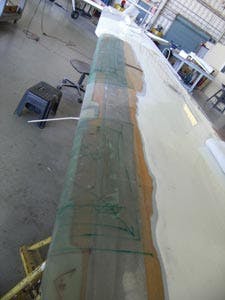Airframe Technology: Composite Repair Training
The use of composite materials in the construction of aircraft components and primary structure is nothing new to the aircraft industry. Most of today’s aircraft technicians have some level of exposure to advanced composite parts and structures, and some may be routinely faced with making large repairs to advanced composites. Like everything the aircraft technician does these days training plays a huge role in accomplishing composite repairs.
There are many companies today that provide composite repair training and a search of the Internet will result in many choices. Many large companies will develop course curriculum and provide composite repair training in-house that is specific to their needs and the equipment they operate. The airlines, military, and large repair stations are good examples of this.
They may develop courses based on the manufacturer’s requirements in the structural repair manuals or other maintenance manuals, and the training is taught by instructors in their technical training departments. Due to the size of the fleets and high volume of work, technicians working at these maintenance organizations have the ability to easily remain current on composite repair procedures and techniques. Additionally, manufacturers of aircraft and composite repair equipment will provide training to the aircraft technician.
Small repair shops
However, advanced composites are not only used on large aircraft or components. Many of today’s small general aviation (GA) aircraft use advanced composites in their construction. So what do these small repair shops do for advanced composite repair training? Some of these shops may only need to accomplish small composite repairs on a limited basis. How do these shops manage the need for specialized training on advanced composite repair techniques and practices? To help understand their unique situations, AMT spoke with two GA repair shops to explore how training on advanced composite repairs has entered into their particular organization. Additionally, we spoke with two manufacturers of popular GA airplanes on what they have to say about training for small GA shops.
Cirrus Aircraft uses advanced composite materials in the manufacturing process of its aircraft. AMT spoke with Jerry Serres from Quality Aviation a small fixed base operator (FBO) shop in Minnesota and an authorized service center for Cirrus Aircraft. Quality Aviation has been a Cirrus service center for nine years. One of the requirements to become an authorized service center for Cirrus Aircraft is for someone in the shop to attend a 40-hour composite repair course taught by Cirrus Aircraft. Serres states they have accomplished several advanced composite repairs, and most have been on a smaller scale.
Serres says, “The repairs we have done so far have not been difficult. The details of the repair layup information have been the most important part.” This detailed information generally comes direct from the factory. Serres recommends to anyone doing composite repairs, “Make sure you are in contact with the factory for any level repair, and send them pictures and drawings describing the damage. We’ve had great support from the Cirrus factory for all of our repairs.”
OEM training
AMT spoke with Tim Wright, manager of technical training for Cirrus Aircraft. Wright explains that Cirrus has a well-developed set of repair criteria in the aircraft maintenance manual (AMM) for accomplishing composite damage evaluation and repairs. “326 technicians have attended the Cirrus Aircraft 40-hour composite repair course,” says Wright. “Other technicians, not just Cirrus authorized service center technicians, can attend the course. However, the course curriculum is designed around the Cirrus aircraft.”
The repair philosophy of Cirrus Aircraft is to design repairs that can be easily accomplished in the field without expensive equipment or the need for fabric materials that are impregnated with resins or adhesives that need high temperature and pressure for curing. Typically these expensive “pre-preg” materials have specific storage requirements and short shelf lives, adding high costs for small repair shops.
For Cirrus, many repairs are accomplished by carefully cutting the damaged area from the aircraft, cleaning and preparing the area according to the maintenance instructions, fitting a replacement section which was fabricated by the factory into the cut-out on the aircraft, and bonding it into place according to the repair instructions provided. Wright says, “The use of wet-layups with slightly elevated curing temperatures, in this application, make it much easier for the general aviation repair shop, while still providing high-quality repairs.”
Light sport aircraft repair
Another type of aircraft to employ advanced composite materials is the light sport aircraft (LSA). For those of you familiar with LSAs many of them use advanced composite materials in their construction processes. And, many small shops are now finding themselves faced with accomplishing advanced composite repairs on LSAs.
Such is the case with Stanton Sport Aviation also located in Minnesota. It operates the Flight Design CTsw aircraft as a rental and training aircraft, and has also become an authorized service center for the Flight Design LSA.
AMT spoke with Kent Johnson of Stanton Sport Aviation on how they managed the need for training on advanced composite repairs. Johnson says, “We first accomplished a few small repairs and we did have some experience on composites having previously accomplished composite repairs on gliders. As one of the only Flight Design (FD) authorized service centers in the upper Midwest, we were soon asked about accomplishing larger more complicated repairs.”
For this shop, training on how to accomplish the larger repairs came in a couple phases. First Johnson attended a composite repair course provided by Flight Design USA through Lockwood Aviation Repair of Sebring, FL. This course taught the basics of identifying material, resins and epoxies, and different layup procedures for accomplishing composite repairs on this type aircraft.
The repair philosophy of Flight Design is also to make it easy as possible for the small repair shop. Tom Peghiny, president of Flight Design USA, says, “There is a misconception that composite repair is extremely difficult. Small dings and non-structural repairs can be repaired with basic training using instructions provided in the maintenance manual that comes with every one of our aircraft. As more and more composite aircraft are now in the field, finding someone to do repairs for our customers has not been a problem.”
The next phase for Johnson came when he was asked to repair an aircraft that suffered some significant wing damage. In this case Flight Design sent a composite repair specialist from the factory in Germany to Minnesota. Similar to the Cirrus example, the damage was carefully removed and replacement sections fabricated by the factory were bonded in place. Johnson says, “We understand the importance of proper training, continued education, and the need for qualified repair shops to handle the growing demand for composite damage repair on small aircraft. The approach we took resulted in two benefits: The shop had the expertise of a factory representative to accomplish the major parts of the repairs, while at the same time providing us with valuable on-the-job training.”
In these two examples the small shops receive their training through or directly from the aircraft manufacturer.
Training companies
In addition to manufacturers, many companies around the world provide individuals or repair shops with basic and advanced repair training. One of these schools is Abaris Training.
Abaris has taught a variety of composite training courses for more than 20 years, and its students have come from airlines, general and corporate aviation, the military, and aviation regulators from the United States and abroad.
Abaris Training recently developed a very comprehensive textbook on composite materials which it uses for some of its training courses. This book has been published by Aviation Supplies & Academics Inc. and is titled, “Essentials of Advanced Composite Fabrication & Repair.” It provides a thorough education in the basics of composites for beginners, yet will also keep the experienced composite repair technician up to date in the advanced composite industry.
Abaris Training recommends this book to those people and shops getting into the composite repair business, and for those already experienced in accomplishing composite repairs.
This textbook may be a great addition to your library and can be referenced for a variety of techniques and practices. As always any aircraft repair needs to be done according to the manufacturer’s instructions or other applicable repair data.

